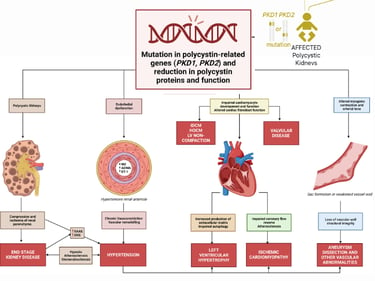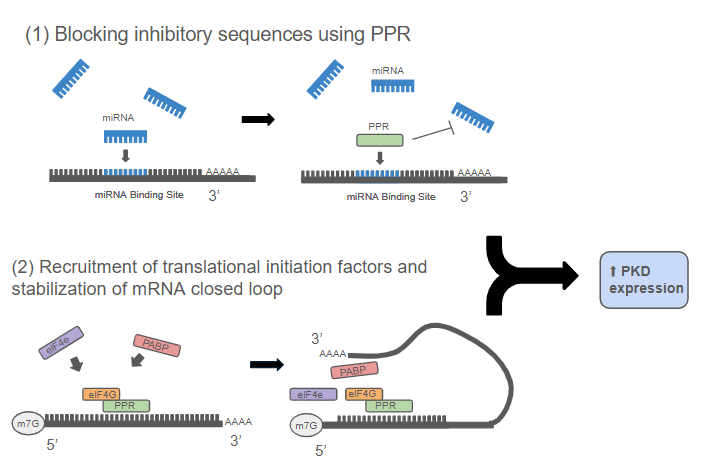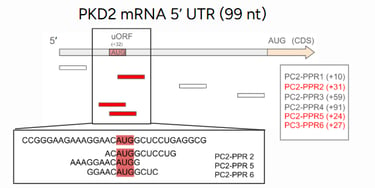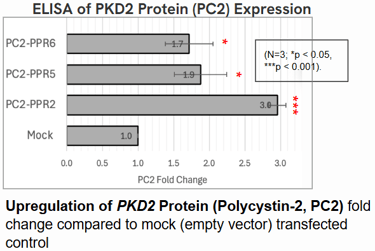Targeted Upregulation of PKD1/PKD2 with Programmable PPR Proteins: A Versatile Approach for Addressing Haploinsufficiency
Summary:
My research focuses on a common genetic kidney disease often caused by insufficient levels of two crucial proteins, PC1 and PC2. To combat this, I designed a new type of molecular tool that acts like a targeted delivery system. This tool seeks out the cell's own instructions for making these proteins and performs two key jobs: it blocks natural "stop" signals that hinder production, while simultaneously recruiting the cell's protein-making machinery directly to the site. In lab tests, this approach successfully boosted protein levels to a therapeutically relevant degree. A key finding was that the tool's success depends heavily on precisely where it attaches to the genetic instructions, highlighting the importance of optimal targeting for future therapies.
Download:
Autosomal Dominant Polycystic Kidney Disease (ADPKD) is one of the world’s most common inherited disorders, affecting more than 12 million people. It arises from mutations in the PKD1 and PKD2 genes, which encode the proteins Polycystin-1 (PC1) and Polycystin-2 (PC2). These two proteins are essential for maintaining healthy kidney cell structure and communication. When their levels fall too low, cysts begin to form, eventually leading to progressive kidney failure.
Traditional genetic therapies, while powerful, often come with risks tied to permanent DNA modification. My research explored a more flexible approach—one that enhances the body’s own ability to produce these vital proteins without altering the genome itself.


Understanding the Challenge: Autosomal Polycystic Kidney Disease


Reprogramming Translation: The PPR-eIF4G System
To boost PKD1 and PKD2 protein production, I engineered synthetic Pentatricopeptide Repeat (PPR) proteins—modular RNA-binding proteins capable of recognizing specific mRNA sequences. By fusing these PPRs to eIF4G, a key translation-promoting factor, I designed hybrid proteins that could both remove inhibitory barriers and stimulate translation.
This system works through two coordinated actions:
Removing roadblocks — targeting microRNA binding sites and upstream open reading frames (uORFs) that suppress PKD translation.
Enhancing efficiency — recruiting ribosome machinery directly to PKD mRNAs, accelerating the production of Polycystin proteins.
This design not only demonstrated the precision of RNA-level control but also showed how synthetic biology tools can repurpose natural mechanisms for therapeutic goals.
Key Findings: How Much Does PPR Enhance Expression of PKD1/PKD2
Testing these engineered proteins in mammalian cells revealed a significant increase in PKD expression.
PKD1 mRNA rose nearly fourfold, while Polycystin-1 (PC1) levels increased by 1.6×.
Polycystin-2 (PC2) protein abundance grew by about threefold.
These results suggest that even moderate increases in Polycystin levels could meaningfully slow or prevent cyst growth in ADPKD.
Interestingly, the effects depended strongly on where the PPRs bound along the mRNA. Shifting a binding site by just a few nucleotides sometimes completely changed the outcome—revealing the fine spatial control needed to fine-tune translation.
Another key insight came from studying microRNA-regulated sites, particularly those involving miR-200. In some cases, increased PKD1 mRNA did not lead to a proportional rise in protein, suggesting that microRNAs may influence broader translation mechanisms beyond simple RNA degradation.




Implications: A Step Toward Gentler Gene Therapy
This work demonstrates that synthetic PPR-based translation enhancement can selectively and reversibly increase protein production in target genes. By acting at the RNA level, this method avoids permanent genome edits—making it potentially safer and more adaptable than traditional gene therapy approaches.
The broader vision is to establish a modular system where customizable PPR proteins could address other genetic diseases caused by haploinsufficiency—conditions in which one working gene copy isn’t enough to produce sufficient protein.
Looking Ahead: From Concept to Impact
Future research can refine this approach by mapping ideal PPR binding sites and pairing them with other translation-promoting domains. Each improvement brings us closer to a toolkit capable of restoring protein function with precision and minimal risk.
Beyond ADPKD, this study contributes to a growing movement in molecular biology: finding ways to translate understanding into action—not just discovering mechanisms, but designing tools that bring hope to real people.
Our team


Genome Chemistry and Engineering Lab
Kyushu University, Japan
Contact
Reach out to discuss ideas or collaborations.
Phone
camtan064@gmail.com
+63 927-114-1655
© 2025. All rights reserved.
Navigation
